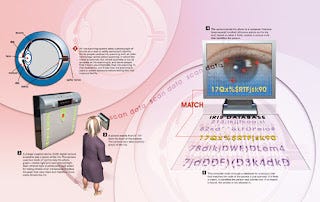The FBI & law enforcement want to use iris scans to track criminals.

By 2014, the FBI plans to test a database for searching iris scans nationwide to quickly track criminals, according to budget documents and a contractor working on the project.
Iris scanning is part of the FBI’s Next-Generation Identification system, a multiyear $1 billion program built by Lockheed Martin and already well underway for several years, which will expand the FBI’s server capacity to allow for rapid matching not only of iris scans, but also of additional physical identifiers, such as fingerprints, palm prints and facial images. The FBI intends to test the system in conjunction with prisons, some of which already use iris scans to track prisoners and prevent mistakes of identification. According to the FBI, the time for urgent criminal fingerprint searches will eventually be reduced from 2 hours to 10 minutes, while the use of iris scans and other markers should ensure greater accuracy.
Today, iris scans conjure images of covert agents accessing high-security banks and laboratories. But law enforcement agencies are increasingly spending state and federal funds on iris recognition technology at jails to monitor inmates. Some Missouri prisons are buying the same system the FBI acquired, partly so that they can eventually exchange iris images with federal law enforcement officials. And many counties are storing pictures of prisoner irises in a nationwide database managed by a private company, BI2 Technologies.
The FBI expects to collect many of these state and local iris images, according to B12 officials and federal documents.
A May 17 budget justification document states one of the “planned accomplishments for BY13 — the budget year that begins Oct. 1 — is to demonstrate iris recognition capabilities via the iris pilot.”
A June FBI advisory board memo that Nextgov reviewed states, “supervised release/corrections are candidates for the pilot, being that many already have the capability in place. The additional goal is to start to build an iris repository.”
Iris recognition is a helpful identification tool, according to the memo, because it “is very accurate,” does not require human intervention and “the hardware footprint is also very small [due] to the size of the iris image.”
The aim of iris recognition at corrections facilities, according to law enforcement officials, is to promptly catch repeat offenders and suspects who try to hide their identities.
Although privacy advocates have little criticism of the use of iris scanning in correctional settings, the fact that the FBI and state prison officials are using a database owned and maintained by a private corporation, BI2 Technologies, gives many pause. Jennifer Lynch, a staff attorney at the digital rights group Electronic Frontier Foundation, points out that privately-run databases, including well-encrypted ones at banks and other financial businesses, have experienced serious data breaches exposing private customer information, and that leaks of fingerprints or iris scans would be potentially much more serious. “You can change your credit card data. But you can’t change your biometric data.”
And in light of the fact that the New York Police Department, in cahoots with major Wall Street banks and finance firms, used security cameras to identify Occupy Wall Street protesters, suspicions that iris scans might be used to target non-criminals who are disliked by powerful cannot be dismissed out of hand. http://mashable.com/2012/07/05/fbi-iris-scans-database/
http://www.allgov.com/Where_is_the_Money_Going/ViewNews/FBI_Prepares_Billion_Dollar_Iris_Recognition_Database_120708
How iris recognition works: An introduction.
http://www.explainthatstuff.com/how-iris-scans-work.html
http://www.hrsid.com/iris-recognition
http://blog.targethealth.com/?p=12875


